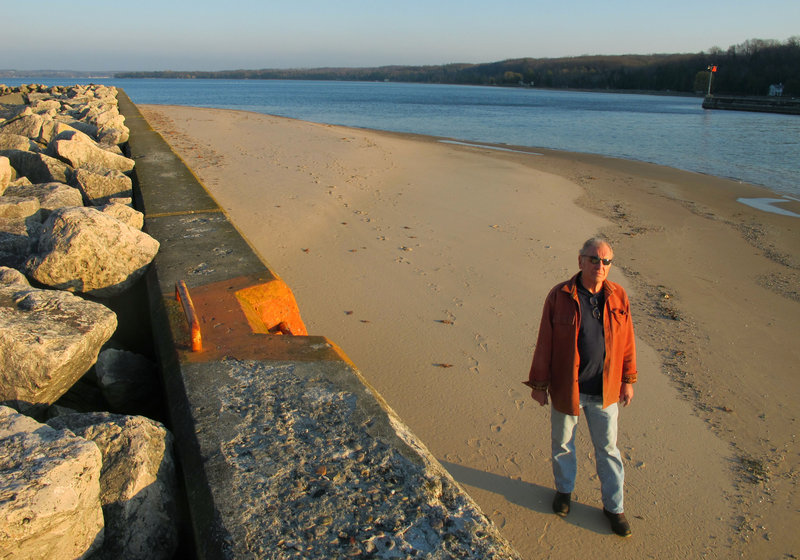ONEKAMA, Mich. — For more than a century, easy access to Lake Michigan has made Onekama a popular place for summer visitors and a refuge for boaters fleeing dangerous storms. Now the community itself needs a rescue, from slumping lake levels that threaten its precious link to open water.
The Great Lakes, the world’s biggest freshwater system, are shrinking because of drought and rising temperatures, a trend that accelerated with this year’s almost snowless winter and scorching summer. Water levels have fallen to near-record lows on Lakes Michigan and Huron, while Erie, Ontario and Superior are below their historical averages. The decline is causing heavy economic losses, with cargo freighters forced to lighten their loads and marinas too shallow for pleasure boats.
Some of the greatest suffering is in small tourist towns that lack the economic diversity of bigger port cities. Yet they are last in line for federal money to deepen channels and repair infrastructure to support the boating traffic that keeps them afloat.
“How do you like our mud bog?” Township Supervisor Dave Meister asked on a recent afternoon, gesturing toward the shoreline of Portage Lake, part of a 2,500-acre inland waterway that connects Onekama to Lake Michigan. A wide expanse that normally would be submerged is now an ugly patchwork of puddles, muck and thick stands of head-high cattails.
The Army Corps of Engineers has estimated that about 30 small Great Lakes harbors will need attention in the next couple of years.
In bygone days, friendly members of Congress would slip money into the federal budget to dredge a harbor. But so-called earmarks have fallen out of favor, leaving civic leaders wondering where to turn.
Tourism has sustained Onekama since the early 1900s, when northwestern Michigan coastal towns became popular with wealthy visitors from Chicago, Milwaukee and Detroit.
But the falling water levels are taking a toll, illustrating how extensively the health of the Great Lakes affects the economy of a region that is home to more than 30 million people.
Lake Michigan’s level at the end of October was more than 2 feet below its long-term average. The Corps of Engineers says without heavy snowfall this winter, the lake may decline to its lowest point since record-keeping began in 1918.
The channel that connects Portage Lake and Lake Michigan is now about 7 feet deep at best. If things get much worse, Onekama may be effectively cut off from the big lake.
“Businesses would close. People would be laid off. It would be devastating,” said Jim Mrozinski, owner of Onekama Marine Inc., which services and stores pleasure craft and draws customers from across the Upper Midwest. He owns three marinas, one now unusable because of shallow water. If he’s lucky, the others will have enough depth to rent perhaps 10 of the 55 slips next spring.
Onekama’s year-round population is less than 2,000. Much of its tax base comes from expensive waterfront homes owned by summer residents who come for the boating and fishing. Without the link to Lake Michigan, property values would plummet, hammering local government budgets, Meister said.
Many places around the Great Lakes are having similar problems. The state of Wisconsin warned boaters to watch for stumps, boulders and other hazards lurking just beneath the water. Boat-towing services have done brisk business rescuing stranded craft in newly shallow stretches of Lake Erie.
What makes the situation particularly frustrating for small Great Lakes communities is that a fund for dredging and other harbor maintenance already exists. It’s generated by a tax on freight shipped at U.S. ports and raises about $1.5 billion a year. But about half of the money is diverted to the treasury for other uses. Members of Congress from coastal states are pushing to change that policy.
Even if the effort succeeds, there’s no guarantee that communities like Onekama will get a share of the cash. The Corps of Engineers gives top priority to large ports such as Duluth, Minn., Detroit and Cleveland. Whatever is left goes to medium-sized harbors that also accommodate cargo ships. The region’s 112 small harbors, including 71 with only recreational traffic, have relied on budget earmarks since the 1990s.
“Many of these towns wouldn’t exist if it wasn’t for their ports,” said Mike O’Bryan, chief of engineering and technical services for the Detroit district office.
The Great Lakes Small Harbors Coalition, led by Onekama retiree Chuck May, says $20 million a year would cover all those areas’ dredging and maintenance costs, and rescue tourist communities that pump billions into the economy.
Send questions/comments to the editors.



Success. Please wait for the page to reload. If the page does not reload within 5 seconds, please refresh the page.
Enter your email and password to access comments.
Hi, to comment on stories you must . This profile is in addition to your subscription and website login.
Already have a commenting profile? .
Invalid username/password.
Please check your email to confirm and complete your registration.
Only subscribers are eligible to post comments. Please subscribe or login first for digital access. Here’s why.
Use the form below to reset your password. When you've submitted your account email, we will send an email with a reset code.